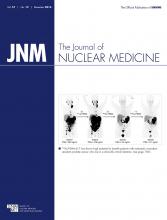Abstract
Recent advances in SPECT technology including cadmium–zinc–telluride (CZT) semiconductor detector material may pave the way for absolute myocardial blood flow (MBF) measurements by SPECT. The aim of the present study was to compare K1 uptake rate constants as surrogates of absolute MBF and myocardial flow reserve index (MFRi) in humans as assessed with a CZT SPECT camera versus PET. Methods: Absolute MBF was assessed in 28 consecutive patients undergoing adenosine stress–rest myocardial perfusion imaging (MPI) by 99mTc-tetrofosmin CZT SPECT and 13N-ammonia PET, and MFR was calculated as a ratio of hyperemic over resting MBF. Results from both MPI methods were compared, and correlation coefficients were calculated. The diagnostic accuracy of CZT MFRi to predict an abnormal MFR defined as PET MFR less than 2 was assessed using a receiver-operator-characteristic curve. Results: Median MBF at rest was comparable between CZT and PET (0.89 [interquartile range (IQR), 0.77–1.00] vs. 0.92 [IQR, 0.78–1.06] mL/g/min; P = not significant) whereas it was significantly lower at stress in CZT than PET (1.11 [IQR, 1.00–1.26] vs. 2.06 [IQR, 1.48–2.56] mL/g/min; P < 0.001). This resulted in median MFRi values of 1.32 (IQR, 1.13–1.52) by CZT and 2.36 (IQR, 1.57–2.71) by PET (P < 0.001). The receiver-operator-characteristic curve revealed a cutoff for CZT MFRi at 1.26 to predict an abnormal PET MFR yielding an accuracy of 75%. Conclusion: The estimation of absolute MBF index values by CZT SPECT MPI with 99mTc-tetrofosmin is technically feasible, although hyperemic values are significantly lower than from PET with 13N-ammonia, resulting in a substantial underestimation of MFR. Nevertheless, CZT MFRi may confer diagnostic value.
- myocardial flow reserve (MFR)
- myocardial blood flow (MBF)
- cadmium zinc telluride (CZT) SPECT
- 13N-ammonia PET
Footnotes
- © 2016 by the Society of Nuclear Medicine and Molecular Imaging, Inc.







